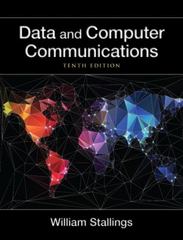Consider a CDMA system in which users A and B have the Walsh codes (1 1 1
Question:
Consider a CDMA system in which users A and B have the Walsh codes (−1 1 −1 1 −1 1 −1 1) and (−1 −1 1 1 −1 −1 1 1), respectively.
a. Show the output at the receiver if A transmits a data bit 1 and B does not transmit.
b. Show the output at the receiver if A transmits a data bit 0 and B does not transmit.
c. Show the output at the receiver if A transmits a data bit 1 and B transmits a data bit 1. Assume the received power from both A and B is the same.
d. Show the output at the receiver if A transmits a data bit 0 and B transmits a data bit 1. Assume the received power from both A and B is the same.
e. Show the output at the receiver if A transmits a data bit 1 and B transmits a data bit 0. Assume the received power from both A and B is the same.
f. Show the output at the receiver if A transmits a data bit 0 and B transmits a data bit 0. Assume the received power from both A and B is the same.
g. Show the output at the receiver if A transmits a data bit 1 and B transmits a data bit 1. Assume the received power from B is twice the received power from A. This can be represented by showing the received signal component from A as consisting of elements of magnitude 1 (+1, −1) and the received signal component from B as consisting of elements of magnitude 2 (+2, −2).
h. Show the output at the receiver if A transmits a data bit 0 and B transmits a data bit 1. Assume the received power from B is twice the received power from A.
Step by Step Answer:







